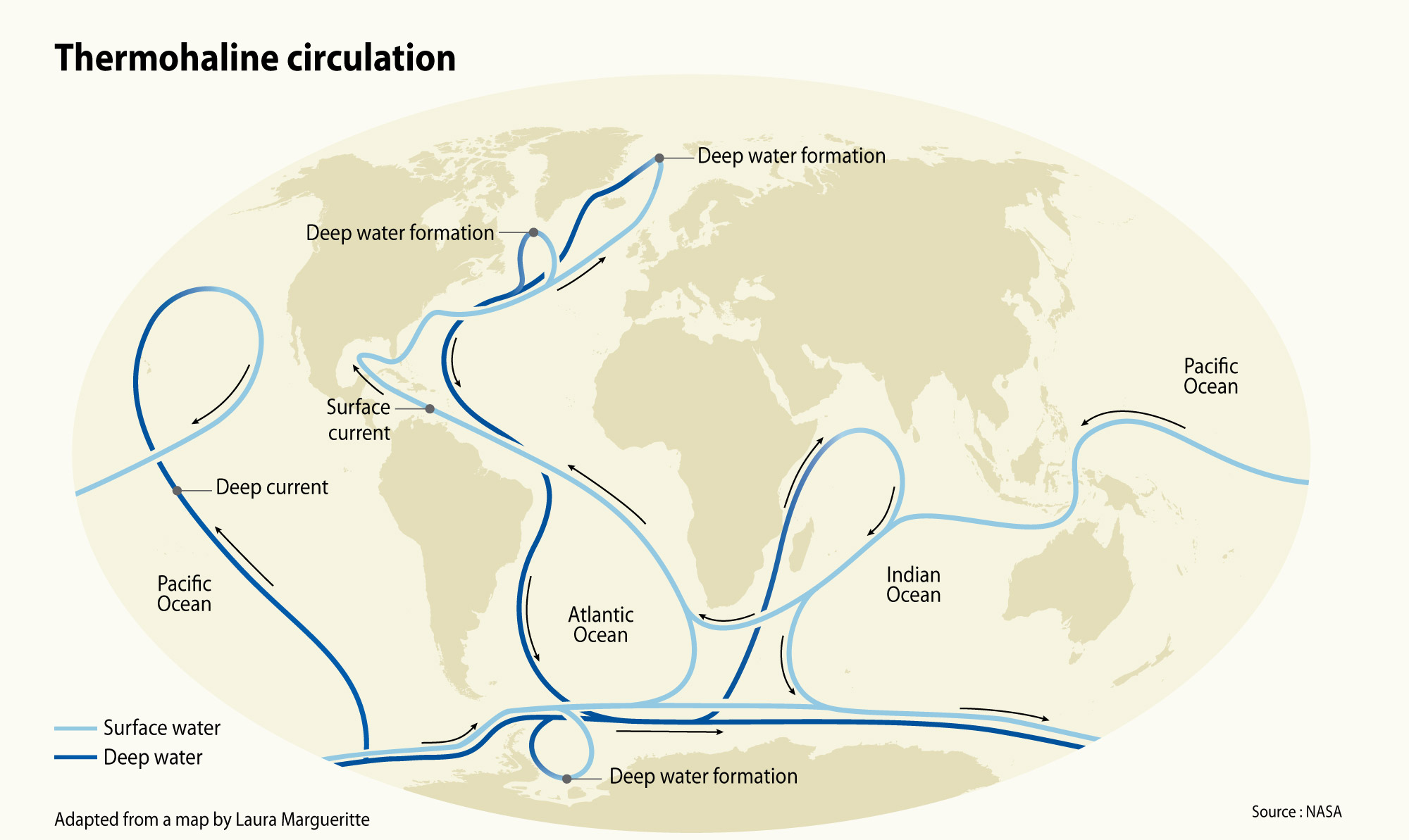-
Q. Discuss the concept of ocean thermohaline circulation and its role in global climate regulation. How could changes in this system impact Earth's climate? (250 words)
26 Aug, 2024 GS Paper 1 GeographyApproach
- Introduce the answer by defining Ocean thermohaline circulation
- Delve into the role of OTC in global climate regulation
- Give impact of Potential Changes in Ocean Thermohaline Circulation
- Conclude suitably.
Introduction
Ocean thermohaline circulation (OTC) is a complex system of currents driven by differences in temperature and salinity.
- Warm, salty water at the surface is more buoyant than cold, fresh water, causing it to sink in certain regions. This sinking water is replaced by surface water, creating a continuous circulation pattern.
Body
Role of OTC in Global Climate Regulation:
- Heat Transport: By transporting heat from the tropics to the poles, OTC helps to moderate temperature extremes.
- This prevents the tropics from becoming too hot and the poles from becoming too cold.
- Example: Gulf Stream carries warm water from the tropics to Europe, influencing the climate of Western Europe.
- Carbon Cycle: OTC plays a crucial role in the global carbon cycle by transporting carbon dioxide from the atmosphere to the deep ocean.
- It does this through the process of carbon sequestration, where CO2 is absorbed by surface waters, sinks with colder, denser water, and is stored in the deep ocean for centuries, helping to regulate atmospheric CO₂ levels and mitigate climate change.
- Nutrient Cycling: OTC transports nutrients from the deep ocean to the surface, supporting marine productivity and fisheries.
- In regions where deep water rises to the surface, such as the coast of Peru, nutrient-rich waters are brought to the surface.
- These nutrients, including nitrogen, phosphorus, and iron, are essential for marine phytoplankton growth.
- In regions where deep water rises to the surface, such as the coast of Peru, nutrient-rich waters are brought to the surface.
Impact of Potential Changes in Ocean Thermohaline Circulation:
- Slowing or Shutdown of Circulation: A disruption in ocean circulation could lead to significant climate impacts, such as rapid cooling in the Northern Hemisphere and potential warming in the Southern Hemisphere.
- This shift may also trigger more extreme weather events.
- For example, the Younger Dryas cold period (about 12,900 to 11,700 years ago) is believed to have been caused by a disruption in North Atlantic circulation.
- Altering Precipitation Patterns: Changes in ocean circulation can alter global precipitation patterns, leading to shifts in monsoon systems and changes in the frequency and intensity of storms.
- A weakening of the Atlantic Meridional Overturning Circulation (AMOC) could reduce rainfall in the Sahel region of Africa, worsening drought conditions and impacting local agriculture and water resources.
- Sea Level Changes: Variations in ocean circulation can cause regional differences in sea level rise, leading to potential coastal flooding and erosion.
- Recent studies state that potential collapse of the Gulf Stream by 2025 could have severe consequences on global climate patterns.
- Impact on Marine Ecosystems: Disruptions in ocean circulation can affect marine ecosystems by altering nutrient availability and productivity, leading to shifts in species distribution and migration patterns.
- Changes in upwelling patterns off the coast of California, for example, could impact the distribution of krill, affecting the entire food web.
Conclusion
Ocean thermohaline circulation is a critical component of Earth's climate system, influencing temperature, carbon sequestration, and marine productivity. As climate change continues to alter ocean temperatures and salinity, understanding the potential impacts on OTC is essential for predicting future climate trends and developing effective mitigation strategies.
To get PDF version, Please click on "Print PDF" button.
Print PDF






